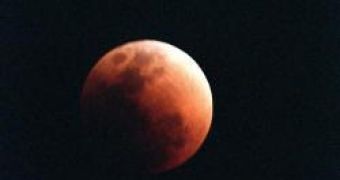The last lunar eclipse that took place on February 20th-21st, ranking 3 on the brightness scale of lunar eclipses which ranges from 0 to 4, seems to confirm that Earth's atmosphere contains light-blocking volcanic ash that could contribute to the acceleration of global warming on our planet. During the span of the eclipse, scientists have been able to obtain valuable information related to the atmosphere, by measuring the amount of refracted light, which varies in concordance to the high-altitude volcanic dust content.
Richard Keen from the University of Colorado, a scientist that has been studying the brightness of the Moon from lunar eclipses which took place in 1883 during the eruption of the Krakatoa volcano in Indonesia, and a series of other eclipses that have occurred since 1960, argues that there is a visible dimming of the light coming from the Moon, which can certainly be attributed to volcanic emissions. Skeptics say otherwise.
Usually, the light emitted by the Sun enters the Earth's atmosphere and is refracted temporarily before being sent towards the surface, but the effects of dust can be a lot more severe, ranging as far as a temporary impact of the planet's clime. Alternatively, scientists can use data collected by artificial satellites present in Earth's orbit to study the opacity of the atmosphere; however, they usually have narrow fields of view, thus lunar eclipses remain the preferable instrument while conducting such research. Further still, older records of lunar eclipses can provide with a more accurate reading in relation to the time variable.
The last lunar eclipse, which occurred this month, is rather similar to the one in 1995, when measurements revealed that the stratosphere was clearer and contained less volcanic residue than the amounts recorded in the previous three decades. Keen reveals that according to calculations, since 1960, the temperature of the Earth should have risen with about 0.1 to 0.2 degrees Celsius every year, while measurements show that in fact the temperature rise averaged about 0.6 degrees Celsius per year.
This basically means that the global warming effect occurring in the 20th century is mostly due to human activity, even though other factors are also contributing in a large proportion, such as ocean circulation currents or changes in the brightness of the Sun.
Computer simulations conducted at the US National Oceanic and Atmospheric Administration, in Boulder, by Susan Solomon, seem to refute the evidence provided by Keen. Indeed, the amount of volcanic dust in the stratosphere has been higher in the past, but this should have determined a slight cooling of the planet. Keen arguments his theory by stating that the volcanic dust can either have a cooling effect or a warming effect, but the period since 1995 has been one with lower concentrations of volcanic dust, meaning more sunlight reaches the surface which in turn leads to a warming trend.

 14 DAY TRIAL //
14 DAY TRIAL //